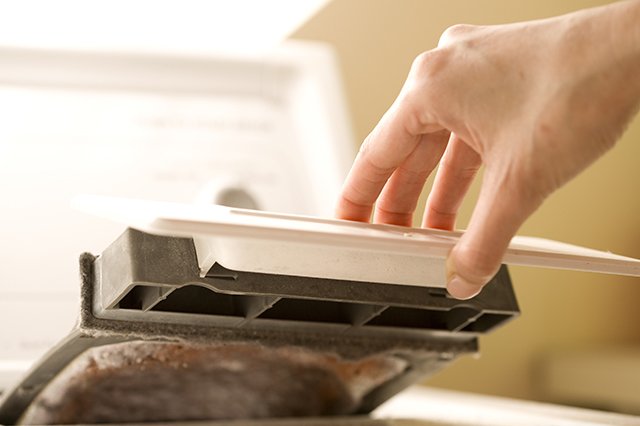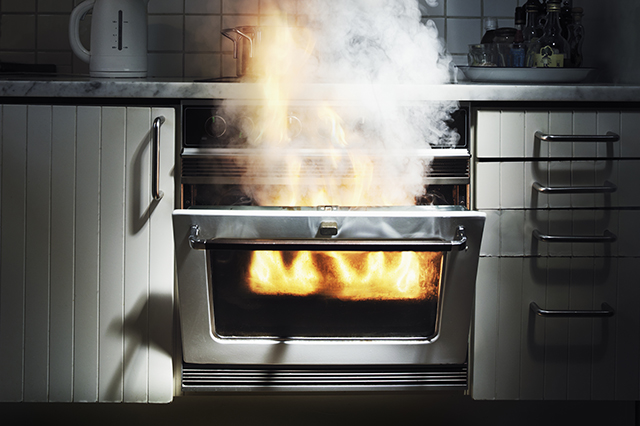Washing clothes, doing dishes and cooking may sound like mundane chores, but the machines involved pose potential risks. Discover the appliance safety hazards in your home, plus how proper cleaning and maintenance can keep these everyday tools operating safely for years to come.
Appliance Safety Around the Home
There are basic safety rules for home appliances big and small. First, have large appliances – like washers, dryers, ovens and refrigerators – professionally installed and serviced. This should ensure your home appliances are properly set up and grounded.
“Be sure you have ground fault circuit interrupter protection anywhere electricity and water are within six feet of each other, such as in your kitchen, bathroom and outdoors, to protect against electric shock,” according to the Electrical Safety Foundation International.
Frequently inspect outlets for discoloration, looseness and warmth. The ESFI also recommends unplugging “all small electrical appliances, such as hair dryers, shavers, curling irons, clothes irons and toasters, when not in use.”
Laundry
Doing laundry is one of those unavoidable chores. Although washers and dryers certainly make life easier, believe it or not, they can be dangerous if you’re not careful. Never leave home with the washer or dryer running.
“In 2010-2014, U.S. fire departments responded to an estimated average of 15,970 home structure fires involving clothes dryers or washing machines each year,” according to the National Fire Protection Association. “These fires caused annual averages of 13 civilian deaths, 444 civilian injuries and $238 million in direct property damage.”
Washing Machine
Before starting the wash, check the pockets of clothes and remove any items – like change, hairpins, pens and stones – that could damage your washing machine or clothing. Then use the right type and amount of laundry detergent specified in your user manual.
Do not overload your washing machine. Excessive shaking or rocking can cause the machine to move, pulling on and potentially loosening hoses and power cords. This can lead to potential slips and falls, water damage and electrical shocks. Periodically check hoses for bulges, cracks and leaks and have them replaced if needed. Install a moisture detector or flood sensor to notify you of potential leaks.
Clean the inside of your washing machine to reduce residue buildup. This could be as simple as using a damp cloth or buying a washing machine cleaner. Whether you’re washing clothes or the machine itself, don’t let water or chlorine bleach sit in your washing machine for an extended period of time. This could lead to rust and erosion.
Front-loading washing machines pose safety risks to pets and small children. The Consumer Product Safety Commission estimates, “since 2014, there have been about 3,000 emergency-room-treated washer-associated injuries among children 5 and younger,” according to Consumer Reports.
To avoid these kinds of injuries, lock the door to the laundry room, use a childproof safety lock on the washing machine door and keep it closed.

Dryer
A majority of laundry-related fires – 92% according to the NFPA – involve dryers. “The leading items first ignited in dryer fires [are] dust, fiber or lint (26% of total) and clothing (26%).”
To lessen the risk of dryer fires in your home, don’t overload your dryer. Also, clean the lint screen before and after every load of laundry. Never run the dryer without the lint filter in place.
Wipe out the interior of your dryer from time to time to catch anything the filter might have missed. Dust, lint and pet fur/hair can gather around the machine as well. Clean around and behind your dryer at least once a year. Keep any flammable materials, like cleaning products, cardboard and clothing, away from the dryer.
Check vents for blockages twice a year. If you have a gas dryer, a certified technician should inspect the gas line, exhaust and venting system.
Kitchen
The kitchen is a focal point and high-traffic area in most homes. This room also houses many appliances that require regular attention.
Dishwasher
Not every home has a dishwasher, but if you find yourself using this appliance, follow these tips.
Don’t overload your dishwasher. This means carefully arranging dishes and utensils to keep sharp objects pointed down and breakables from knocking together, chipping and breaking. Though dishwashers are meant to be convenient, consider hand-washing especially delicate pieces.
Clean out your dishwasher once a month to get rid of residue from soap, hard water and food particles. You can use a sponge or small brush to clean this appliance with non-toxic cleaners like distilled white vinegar and baking soda.
Refrigerator
Start with keeping your fridge at the right temperature; 40 degrees or below is recommended by the U.S. Department of Agriculture. To keep your fridge at the correct temperature, and avoid wasting energy, keep the door(s) closed as often as possible. Don’t store easily perishable foods in refrigerator doors, where the temperature fluctuates too much.
The USDA also recommends throwing out perishables from your fridge once a week, as well as disposing of cooked leftovers after four days and raw poultry and ground meats after one to two days.
To help your refrigerator smell fresh, keep a small bowl or opened box of baking soda in your fridge. For stronger odors, like after food spoils from a power outage, wipe out your fridge with a 1:1 water and vinegar solution and then a baking soda scrub.
Vacuum behind, under and around your refrigerator, and use soapy water to clean the inside regularly. “Avoid using solvent cleaning agents, abrasives and all cleansers that may impart a chemical taste to food or ice cubes, or cause damage to the interior finish of your refrigerator,” says the USDA.
Microwave
Burns are the most common injury associated with microwave ovens. Use pot holders, oven mitts or a towel to take things out of the microwave. Liquids can become “super heated” when microwaved, developing internal “hot spots” that reach temperatures above 212 degrees, according to USDA and Inspection Service.
Only use microwave-safe dishes and containers. This means no metal pans or utensils, aluminum or foam-insulated containers. The U.S. Food and Drug Administration regulates microwave ovens and recommends using ceramic, glass and plastic containers labeled for microwave use.
Stir food halfway through the cooking process to avoid cool spots where bacteria can survive. You can use a food thermometer to make sure food reaches the correct temperature.
Never use a damaged or malfunctioning microwave. You should “contact your microwave’s manufacturer for assistance if your microwave oven has damage to its door hinges, latches or seals, or if the door does not open or close properly,” according to the FDA. This could mean your microwave is leaking radiation.
Oven
Ovens are obviously a higher-risk appliance. Register your oven so you’ll be notified of recalls and other potential dangers. Install childproof handles and knobs on your oven if you have kids, and consider installing baby gates to protect children and pets.
Always check the inside of the oven before starting to cook. Use the right sized pots and pans on burners, and never let handles stick out away from the oven or leave cooking food unattended.
Keep your stovetop and oven clean of food particles and residue that could smoke or catch fire. Store kitchen towels and other flammables away from the stovetop.
When cooking, wear non-slip shoes, tie back long hair and avoid wearing loose clothes. Keep a fire extinguisher or baking soda close to the stove in case of a fire. Have a smoke alarm and carbon monoxide detector close by as well.
Common household appliances make life easier. Though they also pose potential safety hazards, keeping home appliances clean and well-maintained reduces these risks.
Make sure your home is fully protected with homeowners insurance from AAA.
For ways to save at home, go to AAA.com/HomeServices.












